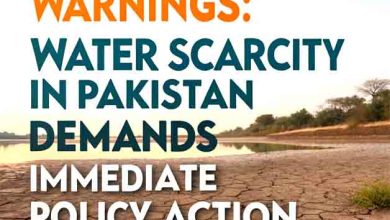Ensuring water security
The News, June 27, 2022
During the past six months, Pakistan has experienced unusually hot and humid weather and unprecedented shortages of water in the Indus Basin canal system, disruption of all kinds of farming activities, reduced power generation by hydropower plants and drying up of drinking water sources in urban areas.
Diminished canal flows also rekindled inter-provincial disputes over water allocations. Climate experts have linked our water crisis to the effects of climate change, adding that such calamities are likely to become a new normal.
The recent water crisis underlines the urgency of accelerated implementation of Pakistan’s first and comprehensive National Water Policy (NWP) approved by the Council of Common Interests (CCI) and signed by the then prime minister, Shahid Khaqan Abbasi, and chief ministers of provinces on April 24, 2018. It seems appropriate to recall how the NWP was agreed and its key targets and means of implementation.
A decision to formulate a National Water Policy was made in 2003 and six successive drafts, prepared with the help of foreign consultants, were considered by the CCI, but none could attract consensus. Finally at its meeting held on November 24, 2017 the CCI constituted an inter-provincial committee under Mr Sartaj Aziz, then deputy chairman Planning Commission, which included the federal ministers of planning and development, energy, and water resources, federal secretaries of water resources, power division, and planning and development and chief secretaries of the four provinces to develop a water policy.
The committee finalized an earlier draft of the NWP after adding the means of implementation, the estimates of financial resources and the institutional arrangements necessary for implementing the policy. An agreed draft of the Policy was considered and approved by the CCI on April 24, 2018. (It is interesting to recall that the 1991 Agreement on the Apportionment of Indus Waters was also finalized by an interprovincial committee chaired by Mr Sartaj Aziz, then federal finance minister).
The National Water Policy (NWP) addresses the spectrum of water-related issues such as the decline in the quantity and deterioration of the quality of water due to population explosion, increasing demands of all user sectors, loss of water during conveyance, over-abstraction of ground water, archaic irrigation methods causing agriculture to use over 80 per cent of available water, decaying water infrastructure, and policy and management deficits. It takes cognizance of the impacts of climate change on water resources, especially more frequent, longer-lasting and severe extreme weather phenomena such as drought, floods and heatwaves.
The main targets of the NWP for the period 2019-2030 include: one, reduction of 33 per cent in the river flows that are lost in conveyance estimated at 46 MAF, through an accelerated programme of water course lining, especially in saline or semi saline areas.
Two, increasing the existing water storage capacity of 14 MAF to 24 MAF, including the Diamer-Basha Dam (6.4 MAF) and Mohmand Dam (0.7 MAF).
Three, an increase of at least 30 per cent in the efficiency of water use by producing ‘more crop per drop’ by deploying micro-irrigation techniques like drip and sprinkler irrigation and more realistic water pricing policy.
Four, adapting drinking water and sanitation plans in line with relevant national policies and the Sustainable Development Goals (SDGs).
Five, gradual replacement and refurbishing of decades-old irrigation infrastructure in accordance with an asset management plan.
Six, real-time monitoring of river flows by the Indus River System Authority (IRSA) through telemetric technology in order to maintain a transparent water accounting system.
Seven, a standardized and uniform mechanism for data collection of water resources at the national and provincial levels including rivers/canals, rainfall, snowfall, depth of groundwater table, surface/subsurface water quality parameters, and reservoir sedimentation.
To achieve the afore -mentioned targets, the NWP requires that at least 10 per cent of the Federal Public Sector Development Programme (PSDP) should be allocated for the water sector, gradually increasing it to 20 per cent by 2030. It also calls upon the provinces to increase their respective allocations for the water sector. In the PSDP for 2017-2018, the water sector had received only four per cent funds. For 2022-2023, this allocation has been increased to 11.3 per cent – Rs91.6 billion out of a total PSDP of Rs800 billion.
The NWP recognizes that the integrated management of water sources requires the highest level of skills and knowledge to effectively address the looming water crisis and calls for wide-ranging institutional reforms and capacity building. These include: first, provincial water authorities: each province is required to set up a provincial water authority to upgrade its capacity to design and construct small and medium sized dams and irrigation infrastructure, while the irrigation departments continue to handle water distribution and maintenance.
Second, ‘groundwater authority’: one of the most significant measures enshrined in the NWP relates to the protection of the rich Indus Aquifer from unsustainable abstraction since the 1960s. Each province is required to establish a regulatory body to curb the unrestricted extraction which has pushed the water table down to dangerously low level, especially in Balochistan and other arid areas. The provincial groundwater authority has to ensure that extractions from the aquifer are sustainable.
Third, National Water Council: the NWP provides for the creation of a National Water Council (NWC), chaired by the prime minister and comprising the four provincial chief ministers/ irrigation ministers. It is required to meet at least once a year to review and coordinate the implementation of the National Water Policy, recommend legislation where necessary and support provincial master plans for water development by providing matching grants. The NWC is to be assisted by an inter-provincial steering committee, chaired by the federal minister for water resources and comprising provincial irrigation ministers or secretaries and chairpersons of the provincial water authorities.
The prime minister should convene a meeting of the National Water Council as early as possible to review the state of implementation of the NWP and approve a roadmap for enhanced action with timelines for the federal and provincial governments.







